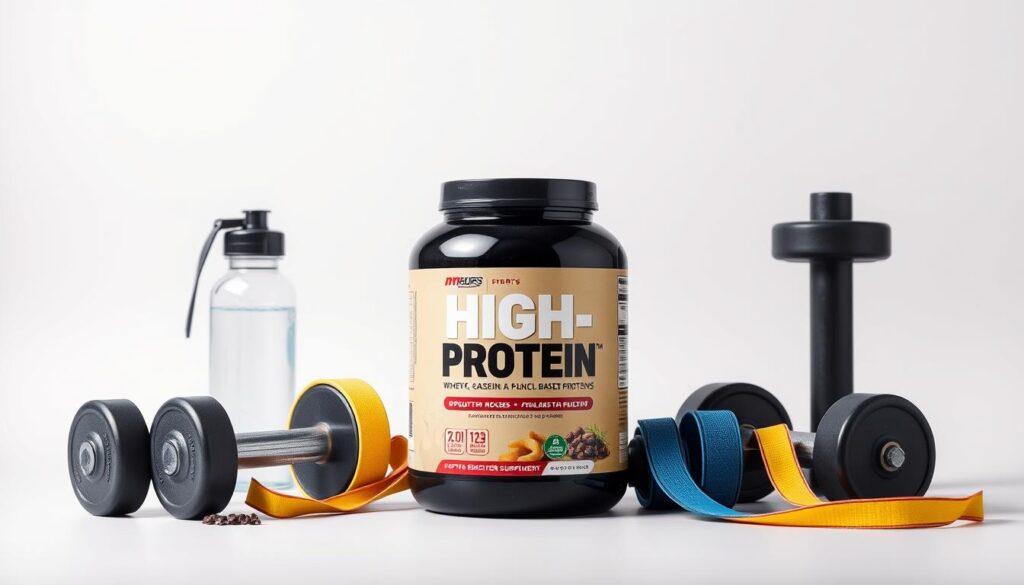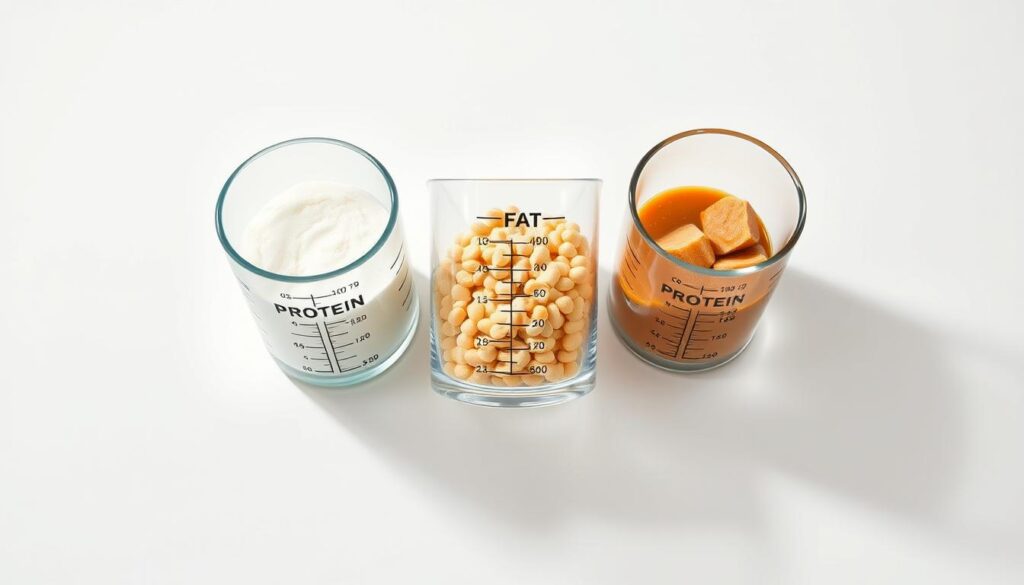Ever felt stuck with diets that make you miss your favorite foods? Many find it hard to stick to plans that cut out whole food groups.
This leaves them feeling hungry and unhappy. There’s a better way to enjoy tasty meals and reach your health goals.
Protein focused nutrition is a smart choice. Women need 50 grams of protein each day, and men need about 60. This way, you can still enjoy foods like steak, burgers, and cheese. It helps you lose weight and improve your body shape.
Studies show eating more protein than usual helps you lose weight. It cuts down fat while keeping muscle mass. These high-protein diet benefits work well with both low-calorie and regular diets.
Learning about optimal protein intake goes beyond just the basics. Protein makes you feel full longer than carbs or fats. It also helps your body burn energy better which is good for your health.
This guide will teach you how to pick the best protein sources and figure out how much you need. You’ll learn how to plan your meals and understand the science behind protein’s effects on your body.
Key Takeaways
- Women need at least 50 grams of protein daily, while men require approximately 60 grams as a baseline
- Eating above recommended amounts reduces body weight and decreases fat mass while preserving muscle tissue
- You can enjoy satisfying foods like steak, burgers, and cheese within this nutritional framework
- Protein creates greater satiety compared to other macronutrients, helping control hunger naturally
- Clinical evidence supports benefits for both reduced-calorie and standard-calorie eating patterns
- This approach focuses on quality sources from both animal and plant origins for balanced nutrition
Understanding High Protein Diets and Why Protein Matters
First, let’s talk about what makes a high-protein diet different. It’s not just about meeting dietary protein needs. Protein is special because it plays a key role in our health. Knowing the right amount can greatly impact your well-being.
The Threshold Between Standard and High Protein Eating
Adults need about 0.80 grams of protein per kilogram of body weight daily. This is roughly 48-56 grams for most adults. It’s the minimum to avoid protein deficiency.
High-protein diets, however, aim for 1.07-1.60 grams of protein per kilogram of body weight daily. This is 27-35% of your total energy intake. It’s a big difference from the standard 16-21%.
For a 150-pound person 68 kg the standard is about 54 grams of protein. A high-protein diet would be 73 to 109 grams. This change requires careful food choices all day.
Protein’s Multiple Functions Throughout Your Body
Protein is more than just for muscles. It’s a key part of your body a source of energy, and essential for growth. Knowing this is why protein intake is crucial for health.
The body uses protein for many important tasks:
- Enzyme production: Proteins make enzymes that start thousands of chemical reactions in your cells
- Hormone synthesis: Many hormones, like insulin and growth hormone, are made from proteins
- Immune function: Proteins create antibodies that fight infections
- Fluid balance: Proteins help keep the right amount of fluid in your blood and tissues
- Nutrient transport: Proteins carry vitamins, minerals, and oxygen around your body
- Cellular repair: Protein fixes and keeps tissues, from skin to organs, healthy
Unlike carbs and fats, protein is not stored in the body for energy. You need to eat it regularly. Your body constantly breaks down and rebuilds proteins needing a steady supply of amino acids.
Protein is the only macronutrient with nitrogen making it key for building and repairing tissues in the body.
What Sets Protein Apart in Macronutrient Comparison
Protein is unique among macronutrients. It has a big impact on metabolism and body shape. The biggest difference is in the thermic effect of food, or DIT.
DIT is the energy your body uses to digest, absorb, and process nutrients. It varies a lot between macronutrients. DIT is 0-3% for fat, 5-10% for carbs, and 20-30% for proteins. This means your body burns more calories processing protein than other nutrients.
Protein also makes you feel full longer. Foods high in protein keep you satisfied longer than carbs or fats. This is because of hormone regulation and slower digestion.
Another key difference is amino acid composition. Protein has essential amino acids your body can’t make on its own. You must get these nine amino acids from food. Carbs and fats can be converted but not essential amino acids.
Protein is also involved in gluconeogenesis, creating glucose from non-carb sources. When carbs are low, your body can turn some amino acids into glucose. This flexibility sets protein apart from other macronutrients.
Understanding these differences shows why protein’s ratio in your diet matters. It affects muscle metabolism appetite, and body shape. These unique properties are the scientific reason behind high-protein diets.
Determining Your Optimal Protein Intake
Your protein needs depend on your lifestyle goals, and body type. Standard guidelines are just a starting point. Knowing your specific needs helps you make better food choices for your health and fitness.
To find your ideal protein intake, look at the recommended amounts, consider your personal factors, and watch for signs of not getting enough. This approach helps you get enough protein without too much.
Standard Protein Recommendations for Adults
Adults need 0.80 grams of protein per kilogram of body weight per day. This is the minimum to avoid protein deficiency for those who are not very active. Women should aim for at least 50 grams of protein daily while men should aim for about 60 grams.
But these numbers are just a starting point. The RDA is about preventing protein deficiency, not maximizing health or fitness. Most adults benefit from eating more protein than the RDA suggests.
Research shows that eating 1.07 to 1.60 grams of protein per kilogram of body weight daily helps with weight loss and improving body composition. Eating up to 1.66 grams per kilogram is safe for healthy people.
Studies on high-protein diets show they are safe for healthy people. These diets provide 25-30% of daily calories from protein for 10-12 weeks. No negative effects were found in these studies.

Factors That Influence Individual Protein Needs
Many things affect how much protein you need beyond just your weight. Knowing these factors helps you adjust your protein intake to fit your life. Age is a big factor as older adults need more protein to keep their muscles.
Your activity level also plays a big role. People who are less active need less protein than athletes or very active people. The type and intensity of your workouts also affect your protein needs.
What you want to achieve with your diet also matters. If you want to gain muscle you need more protein. If you’re trying to lose fat you need more protein to keep your muscle mass. If you just want to maintain your current weight you’ll need a balance between these two.
Other factors that affect your protein needs include:
- Overall caloric intake: Eating fewer calories means you need more protein to keep your muscles
- Health status: Being sick injured or recovering from surgery means you need more protein for healing
- Hormonal differences: Hormones can affect how your body uses protein
- Pregnancy or lactation: These situations increase your protein needs for the health of you and your baby
- Digestive efficiency: How well your body absorbs protein can affect how much you need
These factors all work together in complex ways. What works for one person may not work for another. A young athlete trying to build muscle has different needs than an older person trying to stay healthy or someone recovering from surgery.
Calculating Your Personal Protein Requirements
To figure out how much protein you need, you can use simple math based on your body weight. First, convert your weight from pounds to kilograms by dividing by 2.2. Then, multiply by your target protein factor.
For example, a 150-pound person looking to maintain health might calculate: 150 ÷ 2.2 = 68 kg, then 68 × 1.2 = 82 grams of protein daily. This is a moderate amount that supports overall health.
Athletes and very active people should use higher multipliers. A 180-pound person doing regular resistance training would calculate: 180 ÷ 2.2 = 82 kg, then 82 × 1.6 = 131 grams daily. This amount helps with muscle recovery and growth.
Another way to calculate is based on lean body mass not just total weight. This is especially useful for people with more body fat. If you know your body fat percentage, subtract it from 100 to find your lean mass percentage then apply that to your total weight.
For percentage based calculations divide your target protein grams by your total daily calories then multiply by 100. For example to get 25% of calories from protein on a 2,000-calorie diet: 2,000 × 0.25 = 500 calories from protein, then 500 ÷ 4 = 125 grams daily.
| Goal | Protein Multiplier | Example 150 lbs / 68 kg | Daily Target |
|---|---|---|---|
| General Health | 1.0-1.2 g/kg | 68 × 1.2 | 82 grams |
| Weight Loss | 1.2-1.6 g/kg | 68 × 1.4 | 95 grams |
| Muscle Building | 1.6-2.2 g/kg | 68 × 1.8 | 122 grams |
| Athletic Performance | 1.4-2.0 g/kg | 68 × 1.7 | 116 grams |
Spread your protein intake throughout the day, not all at once. This helps your body absorb and use protein better and keeps your muscles growing.
Signs You May Need More Protein
Your body gives clear signs if you’re not getting enough protein. Recognizing these signs helps you adjust your diet before it affects your health or performance. Feeling hungry soon after eating often means you need more protein as it keeps you full longer than carbs or fats.
Having trouble building or keeping muscle, even with regular workouts, means you might not be getting enough protein. Muscles need amino acids to repair and grow. Without enough protein, your workouts won’t help you much, no matter how hard you try.
Slow recovery from workouts is another sign you might not have enough protein. Feeling sore tired, or weak between workouts means your body is lacking the building blocks for repair. Protein is key for quick recovery.
Common signs of not getting enough protein include:
- Hair thinning or brittle nails: Protein is essential for hair and nail health
- Fluid retention or edema: Not enough protein can disrupt fluid balance
- Frequent minor illnesses: Protein boosts your immune system and helps make antibodies
- Unexplained fatigue: Protein is needed for energy and cellular functions
- Poor wound healing: Protein is crucial for tissue repair
If you notice several of these signs consider increasing your protein intake slowly. Watch how your body responds over a few weeks. Talking to a healthcare provider or registered dietitian ensures your protein intake matches your health goals.
Complete vs Incomplete Proteins What You Need to Know
Protein quality varies a lot in different foods. Some foods give your body all the proteins it needs. Others need to be eaten with other foods to get all the proteins.
This affects how well your body uses protein for fixing tissues, building muscles, and other important functions. Knowing about complete and incomplete proteins helps you plan meals that are full of nutrients.
The idea of protein quality is more than just counting protein grams. It’s about the amino acids in foods and how they match what your body needs. Studies show that eating a lot of protein can make you feel full because of how amino acids work in your body.
Understanding Essential Amino Acids
Your body needs twenty amino acids to make proteins, but it can make eleven of them itself. The other nine essentialamino acids must come from food because your body can’t make them. These amino acids are the building blocks of proteins in your body.
The nine essential amino acids are histidine isoleucine leucine lysine methionine phenylalanine, threonine tryptophan, and valine. Each one has a special role in keeping you healthy. For example, leucine helps build muscle, and tryptophan helps make serotonin.
Lysine helps your body absorb calcium and build collagen. Methionine is important for growing tissues and metabolism. If your body doesn’t get enough of any one of these amino acids it can’t make proteins well.
Studies have looked at how amino acids from protein affect how full you feel. Extra amino acids that aren’t used for making proteins can make you feel full. This is why high-protein diets can help you eat less.
Complete Protein Sources and Their Benefits
Complete proteins have all nine essential amino acids in the right amounts and ratios. These foods are best for your body because they support muscle growth repair, and other important functions without needing other foods.
Animal-based complete proteins include beef, chicken turkey pork fish shellfish eggs milk cheese and yogurt. These foods are often recommended because they naturally have the amino acids your body needs. Eating just one serving of these foods can give your body all the amino acids it needs.
Plant-based complete proteins are less common but still exist. Quinoa and buckwheat are examples of grains that have complete protein. Soy products like tofu tempeh, and edamame also have all the essential amino acids.
Chia seeds and hemp seeds are small but have complete protein profiles. These are great for vegetarians and vegans who want to get all their protein from one food. The best thing about complete proteins is that you need less food to get all the amino acids your body needs.
Incomplete Proteins and Complementary Combinations
Incomplete proteins don’t have enough of one or more essential amino acids. Most plant proteins are incomplete, each with its own amino acid limit. Legumes like beans, lentils, and peas are low in methionine but high in lysine.
Grains like rice wheat oats, and corn have enough methionine but not enough lysine. Nuts and seeds have different amino acid limits depending on the type. These foods are still nutritious but need careful meal planning.
Protein complementation is about mixing different incomplete proteins to get all essential amino acids throughout the day. Rice and beans is a classic combination because rice has methionine and beans have lysine. Hummus with whole wheat pita is another good mix because chickpeas and wheat have complementary amino acid profiles.
Peanut butter on whole grain bread is a simple way to get all the amino acids you need. Modern nutrition science shows that you don’t need to match amino acids at every meal. Your body stores amino acids for hours, so eating different proteins throughout the day is enough.
Eating a variety of proteins throughout the day ensures you get all the amino acids your body needs. This makes it easier to eat plant-based foods. Whether you choose animal proteins plant proteins or a mix knowing about complete and incomplete proteins helps you meet your nutritional needs.
Animal Protein vs Plant Protein A Comprehensive Comparison
Animal and plant proteins have their own nutritional benefits. When choosing your diet, consider what each offers. This helps you pick the right protein for your health goals.
No protein type is better than all others. Your choice depends on your needs values, and diet. Each type has unique benefits.
Nutritional Profiles of Animal Based Proteins
Animal proteins have complete amino acid profiles. They match human needs closely. This makes them great for muscle growth and maintenance.
Animal proteins are nutrient dense. They have vitamin B12, which is only in animal products. This vitamin is key for nerve function and red blood cells. They also have heme iron which your body absorbs better than plant iron.
For example, three ounces of broiled steak has about 25 grams of protein. It also has zinc vitamin D, and omega-3s in fatty fish. Animal proteins are dense, so you need less to meet your daily needs.
But, choose lean meats and dairy to keep saturated fat and cholesterol low. Opt for skinless poultry fish, and lean red meat to get more protein and less fat.
Benefits and Characteristics of Plant Based Proteins
Plant proteins offer more than just protein. They have dietary fiber which animal proteins lack. This fiber helps you feel full and lowers LDL cholesterol, good for your heart.
Beans nuts grains, and soy products give protein and beneficial phytonutrients antioxidants, and anti-inflammatory compounds. One and a quarter cups of beans have as much protein as three ounces of steak. They also have vitamins, minerals, and fiber.
Soy-based foods like tofu and soy burgers are great plant protein sources. Eating 25 grams of soy protein daily may lower cholesterol protecting your heart.
Plant proteins have folate, magnesium, potassium, and vitamins that support health. They also have a lower environmental impact than animal agriculture, making them good for the planet.
Digestibility and Bioavailability Differences
Protein bioavailability is how well your body uses the protein you eat. This affects how well you meet your daily protein needs.
The Protein Digestibility-Corrected Amino Acid Score PDCAAS measures protein quality. Animal proteins usually score 90-100%, meaning your body uses almost all the protein. Plant proteins score 70-90% because of digestion and absorption issues.
Anti-nutritional factors in plants like phytates and lectins, can lower protein bioavailability. These compounds bind to proteins and minerals making them harder to digest. But, cooking and preparing plant proteins can improve their digestibility.
Cooking, soaking, sprouting, and fermenting plant proteins reduces anti-nutritional factors. These methods make plant proteins more like animal proteins in digestibility.
| Protein Source | PDCAAS Score | Key Nutrients | Fiber Content |
|---|---|---|---|
| Beef lean cuts | 92-95% | B12, heme iron, zinc | None |
| Eggs | 97-100% | B12, choline, vitamin D | None |
| Soybeans/Tofu | 91-94% | Folate, magnesium, isoflavones | High 6-8g per cup |
| Black Beans | 75-79% | Folate, iron, potassium | Very high 15g per cup |
| Quinoa | 85-87% | Magnesium, manganese, folate | Moderate 5g per cup |
Making the Right Choice for Your Dietary Preferences
Your best protein plan depends on your health goals, values, budget, and diet. Both animal and plant proteins can support muscle building weight management, and health when chosen wisely.
Omnivores can benefit from a mix of animal and plant proteins. This variety ensures you get all nutrients and can focus on leaner options and plant protein benefits.
Vegetarians can meet protein needs with dairy and eggs supplemented by plant proteins. Cheese, yogurt, and eggs provide high-quality protein and calcium.
Vegans need to focus on variety to get all essential amino acids. Combining different plant sources throughout the day provides complete amino acid profiles without needing to pair them at each meal.
Those on plant-based diets should pay attention to nutrients like vitamin B12, which is not in plants. Iron and zinc absorption can be improved by eating vitamin C-rich foods with plant proteins.
The best high-protein plans include lean proteins and the right amounts of carbs and fats. Whether you choose animal plant or a mix, focus on nutrient density and variety for success.
Best Lean Protein Sources for Your Diet
From the ocean to farms, lean protein sources are everywhere. Choosing the right high-protein foods is key to meeting your protein needs. It also helps manage calories and fat.
Not all proteins are created equal. The best ones have lots of protein with little fat and calories. This guide will help you pick the best protein-rich foods for your diet.
Lean Poultry and Meat Options
Poultry is a top choice for lean protein. Skinless chicken breast has about 31 grams of protein per 4-ounce serving with only 3-4 grams of fat. It’s perfect for those looking for high protein with low fat.
White meat, like chicken breast has less fat than dark meat. But, removing the skin from any poultry greatly reduces fat regardless of meat color.
Beef has become leaner in recent years. Lean cuts like top round steak have almost as much protein as chicken breast. Choose cuts like eye of round, top sirloin, and 93% lean ground beef for great protein with controlled fat.
Pork has also become leaner. Options like pork tenderloin and top loin are as lean as chicken. Today’s pork is much leaner than before earning the nickname the other white meat.
How you cook these high protein foods matters. Choose methods that keep them lean:
- Grilling or broiling lets fat drip away
- Baking without oils keeps protein density high
- Air frying adds crispiness without deep frying
- Trimming fat before cooking reduces saturated fat
- Use marinades with herbs and spices for flavor without calories
Fish and Seafood High in Protein
Fish is packed with protein and low in fat, making seafood a top choice. Even fatty fish offer nutritional benefits that outweigh their fat content. It’s the quality of fats that matters, not just the type.
Lean white fish like cod and tilapia have 20-25 grams of protein per 4-ounce serving with little fat. These mild-flavored fish are great in many recipes and help with weight management.
Fatty fish like salmon and tuna are rich in omega-3s. These fats are good for the heart reduce inflammation, and support brain health. Salmon in particular has 25 grams of protein per 4-ounce serving, along with EPA and DHA omega-3s.
Omega-3 fatty acids in fish are very beneficial. They support heart health, brain function, and provide a lot of protein.
Shellfish is another lean protein source. Shrimp has about 24 grams of protein per 4-ounce serving with less than 1 gram of fat. Scallops, crab, and lobster also offer high protein with minimal calories but cooking methods affect their nutritional value.
When eating fish consider mercury levels. Larger fish like shark have more mercury. The FDA suggests eating lower-mercury fish like salmon and shrimp more often.
Dairy Products and Eggs
Dairy products are great for protein and calcium. Greek yogurt has about 15-20 grams of protein per 6-ounce serving twice as much as regular yogurt. Its thick texture comes from straining which also reduces sugar.
Cottage cheese is another high-protein dairy option. A half cup serving has about 14 grams of protein. Look for low-fat and nonfat versions to keep calories and fat low.
Milk is a complete protein with all essential amino acids. One cup of milk has 8 grams of protein, regardless of fat content. This means skim and low fat milk have the same protein with fewer calories.
Eggs are a good source of lean protein. One large egg has about 6-7 grams of protein with all essential amino acids. Eggs are now seen as safe for heart health thanks to new research.
Egg whites are pure protein with no fat. They’re great for those looking to increase protein without extra calories. However they lack the nutrients found in egg yolks.
Plant-Based Lean Protein Alternatives
Plant based proteins are great for vegetarians vegans, and anyone looking to mix up their diet. These foods offer protein fiber, and antioxidants not found in animal products.
Legumes are a key part of plant based protein. Lentils chickpeas and black beans have 15-18 grams of protein per cooked cup. They’re also high in fiber, which aids digestion and keeps you full.
Soy products are another standout. Here’s a comparison of popular soy based options:
| Soy Product | Protein per Serving | Serving Size | Key Benefits |
|---|---|---|---|
| Firm Tofu | 15 grams | 1/2 cup | Absorbs flavors, versatile texture |
| Tempeh | 16 grams | 1/2 cup | Fermented for digestibility, nutty flavor |
| Edamame | 17 grams | 1 cup | Whole food form, rich in fiber |
| Soy Milk | 7 grams | 1 cup | Fortified with calcium and vitamins |
Research shows that 25 grams of soy protein daily may lower cholesterol. This makes soy a great choice for heart health.
Seitan, made from wheat gluten, is very protein-rich. It has about 21 grams of protein per 3-ounce serving. Its meat-like texture makes it popular in plant-based dishes, but it’s not for those with gluten sensitivity.
Protein-rich whole grains like quinoa and amaranth are rare in plants. Quinoa has 8 grams of protein per cooked cup along with iron magnesium, and fiber. It’s better than refined grains for nutrition.
Nuts and seeds add protein and healthy fats but watch their calorie count. Two tablespoons of nut butter have about 7-8 grams of protein. Almonds, pumpkin seeds chia seeds, and hemp seeds each offer unique nutrients.
Mixing up your protein sources ensures you get all the nutrients you need. Whether you choose animal plant or a mix, focus on lean options for the most nutritional value.
Protein for Muscle Building and Athletic Performance
Protein is more than just food it’s key for athletes and gym-goers alike. It helps build muscle and boosts performance. Studies show that eating enough protein can help you lose fat and keep muscle mass.
Protein keeps your muscle mass stable even when you’re losing weight. This is crucial for those who train hard or are on a diet.

Read more: Vitamin C Can Help Maintain Muscle Mass
How Protein Supports Muscle Growth and Recovery
Protein is essential for muscle repair and growth. It helps your muscles rebuild after they break down. This is important for muscle growth and recovery.
Working out triggers muscle growth. Your body builds new muscle tissue after exercise. This is when protein from your diet is most important.
Amino acids from protein help fix muscle damage and build new muscle. This increases muscle size and strength. Research shows that protein helps with fat loss and muscle gain.
Enough protein helps your muscles grow and recover. It also reduces muscle damage and soreness after workouts.
Protein is also important for recovery. It helps your body heal faster and get back to peak performance. This means you can work out harder and more often.
Protein Timing and Distribution Throughout the Day
The idea of an anabolic window suggests eating protein right after working out is best. But, research shows that eating protein throughout the day is more important. Eating protein after a workout is still a good idea.
Eating protein at regular intervals helps your muscles grow. Aim for 20-40 grams of protein per meal. This way, your muscles get a boost at every meal.
Having protein before bed is also beneficial. It helps your muscles recover while you sleep. This is especially helpful for athletes or those trying to lose weight.
Protein Requirements for Different Activity Levels
How much protein you need depends on your activity level and goals. Knowing this helps you get the right amount for your needs.
| Activity Level | Protein Requirement g/kg body weight | Example for 150 lb Person | Primary Goal |
|---|---|---|---|
| Sedentary adults | 0.8 g/kg | 55 grams daily | Maintenance and basic health |
| Recreationally active | 1.0-1.4 g/kg | 68-95 grams daily | General fitness support |
| Strength and power athletes | 1.6-2.2 g/kg | 109-150 grams daily | Muscle growth and performance |
| Endurance athletes | 1.2-1.6 g/kg | 82-109 grams daily | Recovery and endurance adaptation |
| Caloric restriction for fat loss | 1.8-2.7 g/kg | 122-184 grams daily | Muscle preservation during weight loss |
When you’re on a diet, you need more protein to keep your muscles from breaking down. This is important for losing fat without losing muscle.
Studies show that when you eat enough protein you tend to lose fat mass and keep muscle mass. This is key for healthy weight loss.
Combining Protein with Resistance Training
Protein and resistance training work together to build muscle. Both are important for muscle growth. Together they offer better results than either alone.
Working out damages your muscles and triggers growth. Protein provides the necessary building blocks and hormonal support. Without protein your muscles won’t grow even with intense workouts.
To get the most out of your workouts, focus on these key factors:
- Training frequency: Aim for 2-4 sessions per week to challenge your muscles without overdoing it.
- Progressive overload: Increase the weight or reps over time to keep pushing your muscles.
- Adequate recovery: Give your muscles 48-72 hours to recover between workouts.
- Consistency over time: Stick to your workout and protein plan for weeks to see results.
With enough protein and resistance training, you can keep or even increase your muscle mass even when losing weight. This is hard to do without enough protein no matter how hard you train.
High-protein diets help you keep your muscle mass and burn calories even when you’re losing weight. This makes losing fat easier and helps prevent the slowdown in metabolism that often happens with dieting.
Protein Rich Meal Planning Strategies
Planning meals rich in protein is key to meeting your dietary goals. It makes eating protein focused both easy and enjoyable. By planning well you can turn abstract nutritional goals into real, balanced meals that fit your busy life.
Many find it hard to meet protein goals without a good plan. By using smart meal planning and shopping, you can make high-protein eating a habit. This works for both animal and plant-based proteins, or a mix of both.
Creating Nutritionally Complete Protein-Centered Meals
Building balanced meals starts with a protein base of 20-40 grams. This can be grilled chicken, baked salmon or lean ground turkey. You can also use tempeh or a mix of legumes and grains.
Adding fiber-rich veggies is key, not cutting out food groups. Include non-starchy veggies like broccoli and cauliflower. Also, add starchy veggies like sweet potatoes, based on your carb needs. These veggies add fiber, vitamins, and minerals.
Healthy fats are also important. Use avocado, nuts, or olive oil for flavor and nutrition. They help with nutrient absorption and keep you full without too many calories.
Optional whole grains can add protein and fiber. Choose nutrient-dense options like quinoa or brown rice. They add B vitamins and help balance your meal.
This approach works for many cuisines and tastes. Try a Mediterranean meal with fish, veggies, and chickpeas. Or, go for an Asian dish with tofu and cauliflower rice. A classic American meal could be chicken, broccoli, and sweet potato.
Complete Daily Eating Plans for Various Energy Needs
Daily meal plans show how to meet protein goals at different calorie levels. These plans keep your diet balanced and varied. They ensure you get enough protein throughout the day.
| Meal | 1,500 Calorie Plan | 2,000 Calorie Plan | 2,500 Calorie Plan |
|---|---|---|---|
| Breakfast | 3 scrambled eggs with spinach, 1 slice whole grain toast 28g protein, 350 cal | 3-egg omelet with vegetables and cheese, 2 slices whole grain toast 35g protein, 480 cal | 4-egg scramble with turkey sausage, vegetables, avocado, 2 slices toast 45g protein, 620 cal |
| Lunch | 4 oz grilled chicken breast over mixed greens with vegetables and vinaigrette 32g protein, 380 cal | 5 oz grilled chicken, quinoa bowl with vegetables, tahini dressing 40g protein, 520 cal | 6 oz salmon, brown rice, roasted vegetables, olive oil 48g protein, 680 cal |
| Snack | Greek yogurt 17g protein, 150 cal | Greek yogurt with berries and almonds 20g protein, 250 cal | Protein smoothie with banana and nut butter 28g protein, 350 cal |
| Dinner | 4 oz lean ground turkey, zucchini noodles, marinara sauce 30g protein, 420 cal | 5 oz lean beef, sweet potato, green beans with almonds 38g protein, 580 cal | 7 oz grilled chicken thighs, quinoa, roasted Brussels sprouts 52g protein, 720 cal |
| Daily Totals | 107g protein 29%, 1,300 calories | 133g protein (27%), 1,830 calories | 173g protein (28%), 2,370 calories |
These plans show how to get enough protein with different foods. They help keep your energy up and support muscle growth. You can change the foods to fit your taste while keeping the protein levels the same.
The best high-protein plans focus on lean proteins and include some carbs. Most high-protein diets limit grains, so choose whole grains with fiber and nutrients.
Time Saving Preparation Techniques for Protein Focused Eating
Meal prep saves time by cooking proteins in bulk. Spend 2-3 hours on a prep day to cook chicken salmon turkey, eggs, and beans. This way you have meals ready for the week.
Put the cooked proteins in individual containers. Label them with what’s inside and when you made them. Cooked proteins stay good for 3-4 days in the fridge or 2-3 months in the freezer.
Choose proteins that stay tasty and firm for a few days. Chicken thighs and meatballs are better than fish. Legumes get better with time, adding flavor to your meals.
Season your proteins differently to add variety. Cook chicken breasts and add different spices to each portion. This makes your meals interesting without extra work.
Batch cook veggies and grains too. Chop veggies cook rice, and make salad bases. These ready to-use items make quick meals on busy days.
Have emergency protein options for when you’re really busy. Keep canned tuna salmon, and rotisserie chicken on hand. These items help when you can’t prep fresh food.
Economical Approaches to High Protein Food Purchasing
High-protein diets don’t have to be expensive. Eggs are a cheap protein source, with 6 grams of protein for 15-20 cents each. A dozen eggs gives you 72 grams of protein for under $3.
Canned fish is also a great value. Tuna costs $1-2 per can, with 20-25 grams of protein. Salmon and sardines add omega-3s and protein at similar prices. They’re good for long-term storage and have all the amino acids you need.
Whole chickens or chicken leg quarters are cheaper than chicken breasts. They have similar protein when you remove the skin. A whole chicken costs $1.29-1.79 per pound giving you 3-4 pounds of meat for less than $6.
Dried beans and lentils are the cheapest protein sources. A one-pound bag costs $1-2 and gives 10-12 servings. Each serving has 7-9 grams of protein. They’re a great source of plant-based protein when paired with whole grains.
Smart shopping can stretch your protein budget. Buy proteins when they’re discounted and freeze them. Compare unit prices to find the best deals. Store brands are often cheaper than name brands without sacrificing quality.
Shopping at discount stores or warehouse clubs can save money. Buying in bulk saves on chicken, turkey, and fish. Greek yogurt in large containers is cheaper than individual cups but has the same protein.
How you prepare food also affects cost. Buying whole foods instead of pre-cooked saves money. Frozen veggies are nutritious and cheaper than fresh lasting longer in the freezer. These tips make high-protein eating affordable for everyone.
Understanding Protein Macronutrient Ratio and High Protein Low Carb Approaches
Choosing the right mix of protein, carbs, and fats is key to a good diet. How you balance these macronutrients affects your energy weight, and muscle growth. Finding the right protein ratio is important for your goals and lifestyle.
Your body uses these nutrients differently. More protein means less carbs or fats to keep calorie intake the same. This change affects hunger metabolism, and body shape.
Standard Macronutrient Ratios vs High Protein Ratios
For general health, the usual diet has 45-65% carbs, 20-35% fats, and 10-15% protein. This mix gives enough protein for basic needs and focuses on carbs for energy. Protein usually makes up only 10-15% of daily calories.
High-protein diets, however, increase protein to 25-30% of calories. This can go up to 30-40% protein 20-30% carbs, and 30-40% fats. These ratios help you tailor your diet to your needs.
Studies show high protein diets can range from 16-45% of calories from protein. Most diets have 27-35% protein. This range lets you find what works best for you.

Read more: Next Gen Protein From Plants to Lab Grown Foods
Higher protein diets make you feel full, burn more calories, and help keep muscle when losing weight. There’s no one-size-fits-all high-protein ratio. It depends on your body and goals.
Your ideal protein ratio depends on several things:
- How you respond to different diets
- Health conditions or metabolism
- How active you are and how hard you train
- Your body composition goals and how fast you want to achieve them
- How well you can stick to a diet long-term
High-Protein Low-Carb Diet Principles
High-protein low carb diets like Atkins and the Zone increase protein and cut carbs. They’re popular for weight loss because they boost protein and reduce carbs. These diets can help you lose weight if done right.
These diets work by making your body burn more fat for energy. When you eat fewer carbs, you lose water and glycogen. This can lead to quick weight loss.
With less carbs, your body starts burning fat for fuel. This can lead to ketosis, where your liver makes ketones from fat. Ketosis happens when you eat less than 50 grams of carbs daily, especially less than 20-30 grams.
Ketosis can make losing weight easier because you feel less hungry. But you don’t need ketosis to lose weight on high-protein diets. Many successful diets include some carbs.
Starting a high-protein low-carb diet can cause temporary side effects. You might feel headaches, irritability, nausea, bad breath, and sleep problems. These symptoms, called “keto flu,” usually go away in a few days to two weeks.
The bad breath comes from acetone, a ketone that comes out through your lungs. Headaches and fatigue often come from not having enough electrolytes and dehydration. Drinking enough water and eating foods with sodium potassium, and magnesium can help.
It’s important to know the difference between nutritional ketosis and diabetic ketoacidosis. Nutritional ketosis is safe and controlled. Diabetic ketoacidosis is dangerous and happens in uncontrolled diabetes.
Be careful with very low-carb diets. They might not give you enough nutrients or fiber. Cutting out too many carbs can lead to nutrient deficiencies. It’s hard to get enough nutrients while following very restrictive diets.
Fiber is a big concern on low-carb diets. It can cause bad breath, headaches, and constipation. Eating low-carb veggies and using fiber supplements can help. But sticking to very restrictive diets long-term is hard.
Balancing Protein with Fats and Carbohydrates
Creating a high-protein diet that’s also balanced and nutritious takes planning. When you eat more protein, you need to eat less carbs fats, or both. The best diet for you depends on your body and how well you can stick to it.
People with insulin resistance or who want to get into ketosis might do well on low-carb, high-fat diets with lots of protein. But athletes who train a lot might do better with some carbs in their high-protein diet. It’s about finding what works for you.
Start by setting your protein goal first. Then, use the remaining calories for carbs and fats based on your needs. This way, you get enough protein and can adjust the other nutrients as needed.
| Individual Profile | Recommended Protein % | Carbohydrate % | Fat % |
|---|---|---|---|
| Sedentary with insulin resistance | 30-35% | 20-25% | 40-45% |
| Moderately active weight loss | 30-35% | 30-35% | 30-35% |
| Highly active athlete | 25-30% | 40-50% | 25-30% |
| Muscle building focus | 30-35% | 35-40% | 25-30% |
Choose nutrient dense foods, no matter your diet. For carbs, pick veggies fruits whole grains, and legumes. For fats, go for nuts seeds avocados olive oil, and fatty fish. These foods help you meet your macronutrient goals while getting lots of nutrients.
Avoid eating too much of all three macronutrients at once. This leads to too many calories and hinders weight loss. You can’t eat too much of everything and still lose weight.
Make sure to eat enough fiber, even on low-carb diets. Include leafy greens broccoli cauliflower, and zucchini. These veggies are low in carbs but high in fiber and nutrients.
The best diet is one you can stick to. What works for someone else might not work for you. Choose a diet that fits your needs, supports your training, and helps you reach your health goals.
Watch how your body responds to your diet. Pay attention to energy, hunger, workout performance, and weight loss. Use this feedback to adjust your diet as needed. Don’t stick to a diet just because it’s popular. Listen to your body.
Conclusion
Research over 6-12 months shows that high-protein diets are beneficial. They help reduce body weight and improve body shape. This is because they decrease fat while keeping muscle mass.
These diets are safe for healthy adults. Studies found no harm to bones or kidneys. This is good news, as it clears up old worries.
To eat protein well, plan based on your activity, weight, and health. Choose good protein sources like lean meats fish eggs, beans, and low-fat dairy. Spread out your protein intake across meals for best results.
Remember, balance is key. Add veggies, fruits, whole grains, and healthy fats to your diet. This way, you get all the nutrients you need while working on your body shape.
Before starting a diet, talk to your doctor. This is crucial if you have kidney disease, diabetes, or other health issues. They can help you make safe changes to your diet.
Success in the long run comes from protein exercise good sleep, and managing stress. These habits help improve your metabolic health and overall well-being.





